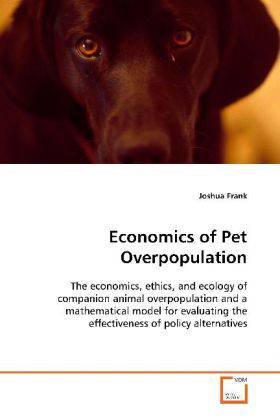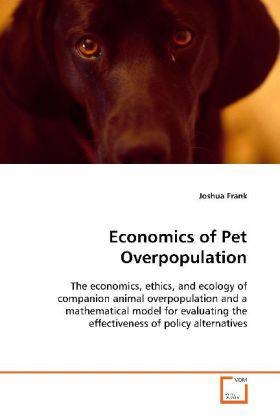
- Afhalen na 1 uur in een winkel met voorraad
- Gratis thuislevering in België vanaf € 30
- Ruim aanbod met 7 miljoen producten
- Afhalen na 1 uur in een winkel met voorraad
- Gratis thuislevering in België vanaf € 30
- Ruim aanbod met 7 miljoen producten
Zoeken
Economics of Pet Overpopulation
The economics, ethics, and ecology of companion animal overpopulation and a mathematical model for evaluating the effectiveness of policy alternatives
Joshua Frank
Paperback | Engels
€ 77,95
+ 155 punten
Omschrijving
Companion animals are a common consumer product with
one estimate indicating that there are 53 million
dogs and 59 million cats living in homes in the
United States. Yet despite the prevalence of this
consumer good, little attention has been given in the
economic literature to the market for companion animals.
This research focuses on the effectiveness of
various methods of reducing the cost of unwanted
dogs. A mixed ecological-economic model of animal
flow dynamics is utilized to study the impact of
various treatments on dog overpopulation. Survey
results for the New York State Capital Region are
utilized to estimate model parameters.
It is found that the "optimal" policy is very
sensitive to the time-scale chosen and how welfare is
defined. Spay/neuter education and low cost
spay/neuter programs are both found to be very
effective, but only using a very long time-horizon
and only with certain welfare definitions.
Increasing shelter space is only found to be cost
effective if the increase in selection is also
assumed to increase adoption rates.
This research will be of use to academicians as
well as practitioners at animal welfare organizations.
one estimate indicating that there are 53 million
dogs and 59 million cats living in homes in the
United States. Yet despite the prevalence of this
consumer good, little attention has been given in the
economic literature to the market for companion animals.
This research focuses on the effectiveness of
various methods of reducing the cost of unwanted
dogs. A mixed ecological-economic model of animal
flow dynamics is utilized to study the impact of
various treatments on dog overpopulation. Survey
results for the New York State Capital Region are
utilized to estimate model parameters.
It is found that the "optimal" policy is very
sensitive to the time-scale chosen and how welfare is
defined. Spay/neuter education and low cost
spay/neuter programs are both found to be very
effective, but only using a very long time-horizon
and only with certain welfare definitions.
Increasing shelter space is only found to be cost
effective if the increase in selection is also
assumed to increase adoption rates.
This research will be of use to academicians as
well as practitioners at animal welfare organizations.
Specificaties
Betrokkenen
- Auteur(s):
- Uitgeverij:
Inhoud
- Aantal bladzijden:
- 212
- Taal:
- Engels
Eigenschappen
- Productcode (EAN):
- 9783639118476
- Uitvoering:
- Paperback
- Afmetingen:
- 220

Alleen bij Standaard Boekhandel
+ 155 punten op je klantenkaart van Standaard Boekhandel
Beoordelingen
We publiceren alleen reviews die voldoen aan de voorwaarden voor reviews. Bekijk onze voorwaarden voor reviews.








